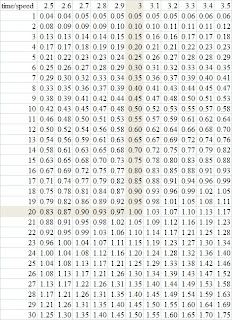You hiked from the south to the hilltop in the SW corner. You want to make your way bushwacking to the camp in the NW corner. You have no waypoints in the GPS. The "trail" was drawn by me. There is no existing trail.
The following method is just the way I would do it. There probably other better ways. All the waypoints could be entered at the start, but I feel the chances of doing that without an error are small.
Rather than going in a direction until encountering an obstacle, I feel it is better to preplan a route before starting.
The first step would be to draw an azimuth (straight line) to the Camp. Since I can't walk on water, that obviously isn't going to work. There is no reason to measure the azimuth.
So, I started by drawing a "trail." I try to make it along contour lines as much as possible and to change altitude where the contour lines are furthest apart. I also have an eye for terrain features I could orient myself with along the way. Sometimes it was just to get a nice view.
After drawing the trail, I put a tick mark every 1/10 mile. The next step is to make a list of bearings and distances. Don't forget to adjust for variation. Since doing this exercise, I've decided a protractor is part of my essential equipment. It could be done with just a compass, but it is very difficult.
Personally, I would write down all the bearings and distances before starting on the trail. As I get to each one, I'd mark it on the map and check it on the list.
I've added an extra column for 180 degrees out from the MH to use with the GPS in the next step. To prevent errors, it's probably worth taking the time to compute and write these down before starting..
Set up your trip summary screen so you can see the distance and bearing to the waypoint you are navigating to.
Mark the start as a waypoint and select 'goto" the start. (Point 1 in this example.) I know, you are already there. Then use your compass to site on something in a distance using the MH to the next waypoint. Head in that direction. Be sure to check for reasonableness so you don't go 180 out. The first heading is 92.72.
As you walk, check your summary screen for the bearing and distance to the start (point 1 in this example) adjusting as necessary. The bearing you are trying to maintain is the reciprocal of the MH to the next point.
When you get the next waypoint, stop. Using 002 as an example, your bearing will be 272.22 and the dist 0.1 miles to waypoint 1. Mark that as a waypoint and do it again.
This takes practice. It can be practiced anywhere using shorter distances.
Once you get proficient doing it with a GPS, you can practice with just a compass and pacing using terrain features to assist in orientation along the way, this sort of navigation can be very accurate. Until it's practiced once or twice, it seems very confusing. After, it's real simple.
Now, let's see how the trail routing was. The video motion is in steps, so the video appears to stop and start.












